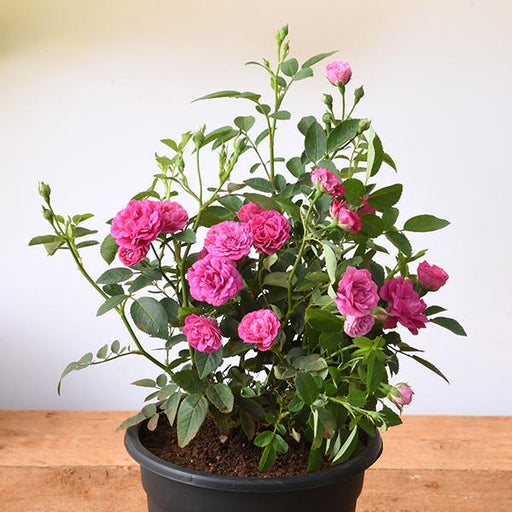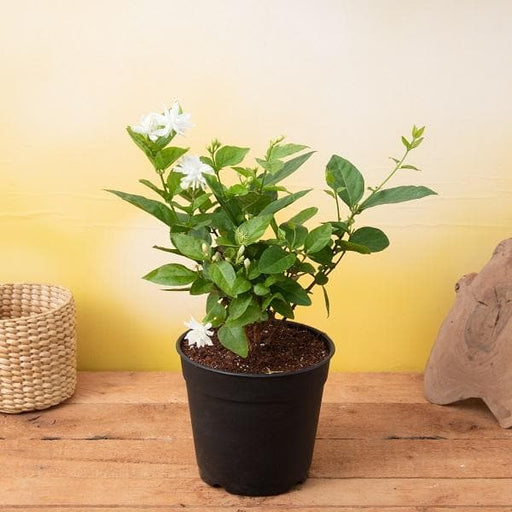
Three Leaved Caper - Plant
(MRP Inclusive of all taxes)
- Shipping ₹79 for entire order
- Dispatch in 7 days
- Country of origin: India

(MRP Inclusive of all taxes)
 Save 29%
Save 29%
Air Purifier Money Plant with Pot The Air Purifier Money Plant, also known as Pothos or Epipremnum aureum, is a stunning indoor plant that...
View full details
 Save up to 15%
Save up to 15%
Peace Lily, Spathiphyllum - Plant The Peace Lily, scientifically known as Spathiphyllum, is a stunning houseplant celebrated for its elegant white...
View full details
 Save 25%
Save 25%
Jasminum sambac, Mogra, Arabian Jasmine - Plant Jasminum sambac, commonly known as Mogra or Arabian Jasmine, is a fragrant flowering plant...
View full details
 Save 18%
Save 18%
Combo Constituents Includes the Parijat Tree (Night-Flowering Jasmine), a culturally significant plant with fragrant flowers. Description The Pari...
View full details
 Save 25%
Save 25%
Miniature Rose, Button Rose (Any Color) - Plant The Miniature Rose, also known as the Button Rose, is a charming and compact flowering plant that ...
View full details Save 25%
Save 25%
Damascus Rose, Scented Rose (Any Color) - Plant The Damascus Rose, also known as Rosa damascena, is a timeless symbol of beauty and romanc...
View full details
 Save 17%
Save 17%
Beautiful Fragrant Mogra, Arabian Jasmine Plant with Pot The Beautiful Fragrant Mogra, also known as Arabian Jasmine (Jasminum sambac), is...
View full details Save 15%
Save 15%
Pack of Vermicompost and Neem Cake for House Plants Transform your indoor garden with our premium Pack of Vermicompost and Neem Cake, spec...
View full details
Pack of Plant Growth and Flower Boosters Unlock the full potential of your garden with our Pack of Plant Growth and Flower Boosters! This ...
View full details Save 38%
Save 38%
Combo of Jeevamrut and Neem Raksha for Easy Growth and Protection of Houseplants Transform your indoor garden with our exclusive combo of ...
View full details Save 22%
Save 22%
Plant Nutrients Kit (Pack of 16) for a Healthy Garden Transform your garden into a lush paradise with our Plant Nutrients Kit, featuring 1...
View full details Save 16%
Save 16%
Combo of Top Plant Fertilizers Elevate your gardening game with our exclusive Combo of Top Plant Fertilizers, featuring two bags of premiu...
View full details Save 24%
Save 24%
Pack of 4 Additives to Make Soil Healthy and Nutrient Rich Transform your garden into a thriving ecosystem with our Pack of 4 Additives de...
View full details Save 30%
Save 30%
Transform your gardening experience with our premium Combo of Perlite and Vermiculite. This unique blend is designed to enhance soil aeration and ...
View full details Save 27%
Save 27%
Combo of 2 Vermicompost and Cocopeat - Enrich Your Soil Naturally! Transform your garden into a thriving ecosystem with our Combo of 2 Ver...
View full details
 Save 35%
Save 35%
Best 6 Plants for Perfect Indoor Garden Transform your living space into a lush oasis with our curated collection of the Best 6 Plants for a...
View full details
 Save up to 50%
Save up to 50%
Mini Succulent Garden Pack Transform your space with our Mini Succulent Garden Pack, featuring a delightful collection of 4 any variety beautiful s...
View full details
 Save 30%
Save 30%
5 Best Fragrant Plants Transform your garden or indoor space into a fragrant paradise with our curated selection of the 5 Best Fragrant Plants. Th...
View full details
 Save 24%
Save 24%
Set of 2 Bonsai Looking Grafted Adeniums Transform your indoor or outdoor space with our exquisite Set of 2 Bonsai Looking Grafted Adenium...
View full details Save 45%
Save 45%
Top 4 Die Hard Succulents Pack Transform your indoor or outdoor space with our Top 4 Die Hard Succulents Pack, featuring a curated selecti...
View full details
 Save 30%
Save 30%
5 Best Indoor Plants Pack Transform your living space into a lush oasis with our '5 Best Indoor Plants Pack.' This carefully curated collection fe...
View full details
 Save 25%
Save 25%
Set of 4 Evergreen Air Purifier Plant Pack Transform your indoor space into a lush, green oasis with our Set of 4 Evergreen Air Purifier Pla...
View full details| SrNo | Item Name |
|---|---|
| 1 | Three Leaved Caper - Plant |
The Three Leaved Caper (Capparis spinosa) is a unique and hardy perennial shrub known for its striking three-part leaves and beautiful white to pale pink flowers. Native to the Mediterranean region, this plant thrives in arid conditions and is often found in rocky terrains. Its edible flower buds, known as capers, are a culinary delight, adding a tangy flavor to various dishes.
What makes the Three Leaved Caper special is its ability to flourish in poor soil and withstand drought, making it an excellent choice for sustainable gardening. This plant not only enhances your garden's aesthetic appeal but also contributes to biodiversity by attracting pollinators like bees and butterflies.
One of its standout features is its long flowering season, which can last from spring to fall, providing continuous beauty and interest in your garden. Additionally, the capers harvested from this plant are rich in antioxidants and have been used in traditional medicine for centuries.
If you think the Three Leaved Caper is just a pretty face, think again! This plant is a powerhouse of health benefits. Packed with antioxidants, it’s like a tiny superhero for your body, fighting off free radicals and keeping you youthful. Plus, it’s known to aid digestion and boost immunity. Who knew a plant could be your personal trainer and nutritionist all in one?
Caring for your Three Leaved Caper is easier than keeping a houseplant alive during a pandemic. This resilient little guy thrives in well-drained soil and loves a good sunbath. Just remember, it’s not a fan of soggy feet, so don’t drown it! A little pruning here and there will keep it looking sharp and ready to impress your gardening friends.
The uses of the Three Leaved Caper are as diverse as your favorite playlist. From culinary delights to traditional medicine, this plant does it all. Toss its leaves in salads for a zesty kick or brew them into a tea that’ll make you feel like a wellness guru. It’s the Swiss Army knife of the plant world!
Want to spread the love? Propagating the Three Leaved Caper is as easy as pie—if pie were made from cuttings and soil. Just snip a healthy stem, pop it in some soil, and watch it grow. It’s like giving birth without the labor pains. Soon, you’ll have a mini jungle of capers to show off!
The Three Leaved Caper is a globetrotter, thriving in various habitats from rocky hillsides to sunny gardens. It’s like the adventurous friend who can make any place feel like home. Just give it some sunlight and well-drained soil, and it’ll flourish, making it the perfect addition to your garden party.
If you’re looking to spice up your dishes, the Three Leaved Caper is your new best friend. Its tangy leaves can elevate everything from salads to sauces, adding a burst of flavor that’ll have your taste buds dancing. Who needs fancy restaurants when you have this culinary gem at your fingertips?
The medicinal properties of the Three Leaved Caper are like a treasure chest waiting to be unlocked. Traditionally used to treat ailments ranging from digestive issues to skin irritations, this plant is nature’s pharmacy. Just remember, while it’s great for your health, it’s not a substitute for a doctor—unless you’re playing doctor in your backyard!
Looking to jazz up your garden? The Three Leaved Caper is the perfect landscaping companion. Its unique foliage adds texture and interest, making it a conversation starter for your next garden party. Plus, it’s low-maintenance, so you can spend more time sipping lemonade and less time weeding.
Fear not, the Three Leaved Caper is not easily intimidated by pests. This tough little plant can withstand a few nibbles from insects, but a little vigilance goes a long way. Keep an eye out for aphids and caterpillars, and you’ll be able to protect your leafy friend without breaking a sweat.
The Three Leaved Caper is a bit of a diva when it comes to soil. It prefers well-drained, sandy soil that allows its roots to breathe. Think of it as the Goldilocks of plants—too wet, and it’ll throw a tantrum; too dry, and it’ll sulk. Just right, and it’ll thrive like the star it is!
If you’re impatient for growth, the Three Leaved Caper will keep you on your toes. It’s not the fastest grower in the plant kingdom, but with a little patience and care, it’ll reward you with lush foliage. Think of it as a slow-burn romance; the wait makes it all the more worthwhile!
The Three Leaved Caper, or Capparis trifolia, is a cheeky little shrub that loves to flaunt its three-leafed glory. Native to tropical regions, it’s not just a pretty face; it’s also known for its edible buds and fruits. Think of it as the plant equivalent of a multi-talented celebrity!
Caring for a Three Leaved Caper is like nurturing a diva—give it well-drained soil, plenty of sunlight, and occasional watering. It thrives in warm climates, so don’t let it get too chilly. Just remember, it’s not a fan of soggy feet, so keep that watering can in check!
Absolutely! The Three Leaved Caper is a pot-loving plant that enjoys the cozy confines of a container. Just ensure it has drainage holes and a sunny spot to bask in. It’s like giving your plant a luxury apartment—who wouldn’t want that
Yes, indeed! The Three Leaved Caper is not just a pretty face; its buds and fruits are edible and can add a zesty kick to your dishes. Just think of it as nature’s little seasoning packet. But remember, moderation is key—too much of a good thing can lead to a culinary disaster!
The Three Leaved Caper has a history of being a natural remedy. Traditionally, it’s been used to treat ailments like digestive issues and skin irritations. It’s like having a mini pharmacy in your garden—just don’t forget to consult a professional before you start your herbal healing journey!
The Three Leaved Caper is a slow and steady grower, taking its sweet time to reach maturity. Expect it to take a couple of years to really strut its stuff. Patience is a virtue, and in the plant world, it’s the secret to a flourishing relationship!
The Three Leaved Caper is not a winter warrior; it prefers to stay warm and cozy. If you live in a chilly area, consider bringing it indoors or providing some protection. Think of it as a plant that needs a vacation from the cold—who can blame it
Like any diva, the Three Leaved Caper can attract unwanted guests like aphids and spider mites. Keep an eye out for these pesky pests and treat them with insecticidal soap or neem oil. After all, no one wants a party crasher ruining their plant’s fabulous vibe!
Propagating the Three Leaved Caper is as easy as pie! Simply take cuttings from a healthy plant, let them callous over, and then plant them in well-draining soil. With a little patience and care, you’ll have new little capers sprouting up in no time—talk about a family reunion!
You can find the Three Leaved Caper at local nurseries or online plant shops. Just make sure to check the reviews—nobody wants to end up with a plant that’s more drama than charm. Happy hunting for your new green companion!
The Three Leaved Caper thrives in well-draining soil that’s slightly sandy or loamy. Think of it as a plant that prefers a light, airy environment—no heavy, soggy soils allowed! A little organic matter can help, but keep it light and breezy for optimal growth.